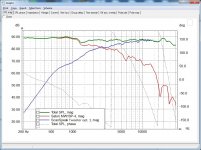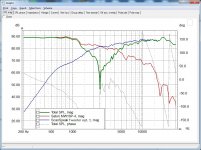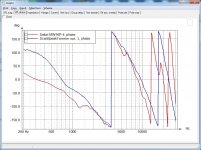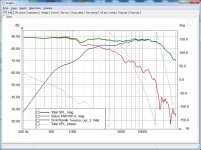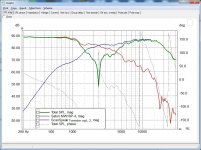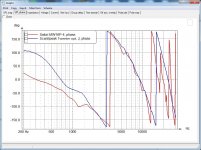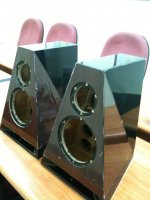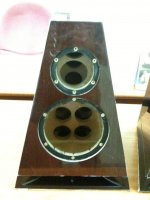I understand what you are saying, you are looking at the amplitude slopes, shaping them as would LR4 electrical filters acting on drivers with no rolloff.
But true LR crossovers also have coherent phase between the crossed drivers. If you replace half the electrical filter with acoustic rolloff don't you lose that phase coherency? A 4th order electrical filter twists the phase faster than 2nd order electrical. I can understand that the rising inductance of the woofer coil adds some phase in the right direction, but does it change fast enough to match an electrical 4th order filter? I understand the low end roll off of the tweeter to be caused by decreasing acoustic impedance which I think will not affect its phase at all, but resonance affects phase. So is it really a true Linkwitz-Riley 4 crossover since phase is not necessarily coherent all the way through the filter band? Or is it?
I see this point made occasionally, that acoustic slope is what matters, but I never had opportunity to ask for clarification about phase until now. It is rare to have accomplished designers willing to share their expertise as you guys are here. Thanks!
Rich
Drivers and circuits are both minimum phase devices. In other words, the phase can be perfectly derived from the frequency response through a Hilbert-Bode Transform.
When you combine a tweeter with a second order natural roll-off with a second order electrical filter in such a way that they combine for a perfect LR4 transfer function then their combined phase will match that of an LR4 transfer function perfectly as well.
If you use an LR4 filter with this tweeter, then the resultant acoustic response will be 6th order, and the phase will be that of a 6th order crossover. In all cases it is the final combined acoustic roll-off that matters for both frequency response and phase. They are inherently tied together.
Jeff B.
Thanks for the info!
Complicated was perhaps a strong word, I would say a bit tricky since I were hoping not to need to equalizing the remaining hump with a LCR circuit (L2+C1+R1), but again this is purely experimental at this stage. See picture 2 and 3.
I haven’t yet finally decided which tweeter to use in combination with the Satori mid-woofer, but I’ve tested a couple of ScanSpeak tweeters on the same baffle, hence the experimental 2.4kHz x-over which seems viable with one of them using a stepped baffle and yes, all your advices is a nice good sum-up of things among others to consider in the chosen design.
Picture 2: Experimental 2.4kHz LR2 x-over
Picture 3: Mid-woofer 15deg off-axis, effect of LCR
Sorry Joachim it wasn’t my intention to hijack your thread, but I was a bit curious and thought it was interesting to compare the different baffle dimensions we used, yours 30cm wide baffle and Jeffs 22.9cm and my 24.8cm.
/Göran
Here's my raw measurement on the baffle and with the crossover. (ignore the part below 250 Hz, it's not that accurate in my room gated. The SPL is not absolute either).
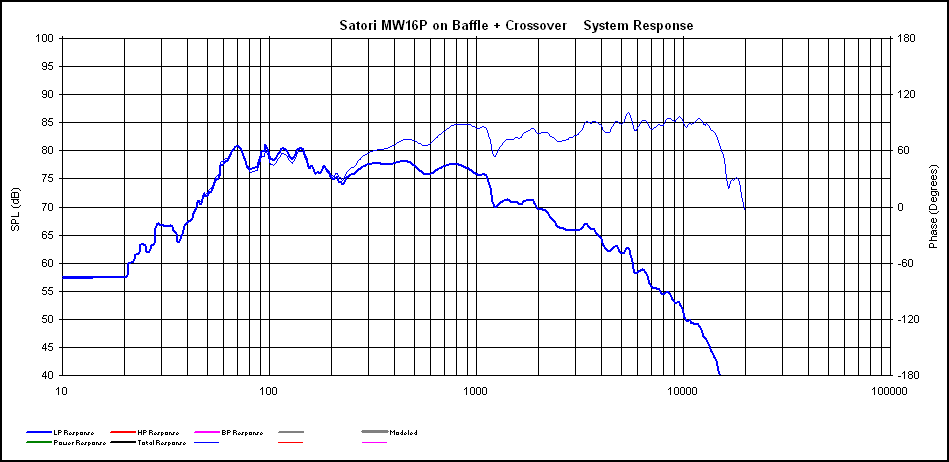
Jeff
Yes, it is the acoustic response that matters. That has the consequence that the crossover schematic does not look like a textbook example at all.
I have made L/R4 and L/R2 filters many times where the phase matched over a very wide range. I do that usually with LSP-CAD and do the rest by trimming with hand while watching the individual phase window.
Here is a picture how the prototype box looks at the moment. I will round the edges and sink in the drivers. After this i will fine tune the crossover.
When the factory made cabinets come i will have to fine tune again.
While Jeff has made a phase linear version and Göran is working on an L/R4 i will stick to the L/R2. We have a lot of options then.
Actually, I'm currently experimenting with a LR2 filter based on a flat baffle measurement, but simulating a stepped baffle.
I will redo measurements based on a stepped baffle later on to see if the simulations are accurate or not.
Perhaps I will also try out a LR4 filter based on a flat baffle measurement later, but currently the LR2 simulation on a stepped baffle looks promising.
Here's a simulation example using two ScanSpeak tweeter options:
Picture 1: Tweeter option 1, tw-axis, on-axis
Picture 2: Tweeter option 1, tw-axis, on-axis, reverse polarity
Picture 3: Tweeter option 1, individual driver unit phase tracking
Picture 4: Tweeter option 2, tw-axis, 15deg off-axis
Picture 5: Tweeter option 2, tw-axis, 15deg off-axis, reverse polarity
Picture 6: Tweeter option 2, individual driver unit phase tracking
The tweeter filter section is very simple and consists of a resistor in series and a single cap + coil (second-order electrically). Listening tests will decide if a LCR notch is needed to flatten out the tweeter's impedance peak at fs.
For further simplicity, tweeter option 1 can even be used without a series resistor if you like the tweeter a bit hot on-axis.
It's certainly not perfect, but interesting enough to explore further and do some listening tests and additional measurements.
/Göran
Attachments
Here's my raw measurement on the baffle and with the crossover. (ignore the part below 250 Hz, it's not that accurate in my room gated. The SPL is not absolute either).

Jeff
You managed to smooth out the hump nicely.
It does seem like the 8 Ohm version has a deeper and sharper suck-out at the edge resonance than the 4 Ohm version.
/Göran
In all cases it is the final combined acoustic roll-off that matters for both frequency response and phase. They are inherently tied together.
Thanks very much Jeff, for taking time to explain so clearly. -Rich
The Satoris are not playing yet but i have come up with a "new" near field listening setup.
I had experimented with Linkwitz Watsons. On some recordings the gain in channel separation and 3D effect was quite staggering. In the end i got a bit tired of this setup.
There can be some "pressure" on the head that is a bit unpleasant. Nevertheless i experimented with sitting closer to the speakers and angling them a bit more outwards.
I found a setup recently that gives some of the Watson effect ( more separation between the channels and a sound stage that is totally detached from the speakers with very good focus ) without the need for a second pair of speakers. I will measure the distances and the angles later to give you an idea how i listen at the moment.
I had experimented with Linkwitz Watsons. On some recordings the gain in channel separation and 3D effect was quite staggering. In the end i got a bit tired of this setup.
There can be some "pressure" on the head that is a bit unpleasant. Nevertheless i experimented with sitting closer to the speakers and angling them a bit more outwards.
I found a setup recently that gives some of the Watson effect ( more separation between the channels and a sound stage that is totally detached from the speakers with very good focus ) without the need for a second pair of speakers. I will measure the distances and the angles later to give you an idea how i listen at the moment.
I haven’t yet finally decided which tweeter to use in combination with the Satori mid-woofer, but I’ve tested a couple of ScanSpeak tweeters on the same baffle, hence the experimental 2.4kHz x-over which seems viable with one of them using a stepped baffle and yes, all your advices is a nice good sum-up of things among others to consider in the chosen design.
/Göran
I think you should just use the Satori TW29R tweeter. This way it'll be an all SB Acoustics speaker
funny how silimar the diy design is to the speakers made by Ingvar Öhman who was mentioned before.

although this is a 8inch dirver in a closed box. Its used with bass modules crossed over at 80 hz.
more examples of his designs here http://www.faktiskt.se/modules.php?...topic&t=8994&postdays=0&postorder=asc&start=0
But I must say that the SB boxes have a more interesting look. But the port tuning must be a bit of a gamble? Perhaps they can make new boxes easily and quick enough?
Thats usually the big drawback with slot ports, one has to make a new box to change the tuning..

although this is a 8inch dirver in a closed box. Its used with bass modules crossed over at 80 hz.
more examples of his designs here http://www.faktiskt.se/modules.php?...topic&t=8994&postdays=0&postorder=asc&start=0
But I must say that the SB boxes have a more interesting look. But the port tuning must be a bit of a gamble? Perhaps they can make new boxes easily and quick enough?
Thats usually the big drawback with slot ports, one has to make a new box to change the tuning..
Last edited:
- Home
- Vendor's Bazaar
- SB Acoustics Satori Monitor
